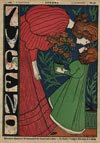

Art nouveau french pronunciation is an international movement and style of art, architecture and applied art—especially the decorative arts—that peaked in popularity at the turn of the 20th century (1890–1905).[3] The name 'Art nouveau' is French for 'new art'. It is also known as Jugendstil, German for 'youth style', named after the magazine Jugend,



which promoted it, and in Italy, Stile Liberty from the department store in London, Liberty & Co., which popularized the style. A reaction to academic art of the 19th century, it is characterized by organic, especially floral and other plant-inspired motifs, as well as highly-stylized, flowing curvilinear forms. Art Nouveau is an approach to design according to which artists should work on everything from architecture to furniture, making art part of everyday life.



which promoted it, and in Italy, Stile Liberty from the department store in London, Liberty & Co., which popularized the style. A reaction to academic art of the 19th century, it is characterized by organic, especially floral and other plant-inspired motifs, as well as highly-stylized, flowing curvilinear forms. Art Nouveau is an approach to design according to which artists should work on everything from architecture to furniture, making art part of everyday life.

Jugenstil poster designers in Berlin included Paul Scheurich, Edmund Edel, Hans Rudi Erdt, Lucian Bernhard, Julius Klinger, Julius Gipkens, Jupp, Wiertz and Joseph Steiner. Many of these artists were still dominating the scene in the 1920s. Some of the posters designed in Austria and Germany at the turn of the century tended, in style, towards a form of Expressionist realism, while retaining a strong link with the decorative motifs of Jugcndstil. After 1900 the floral decorations as a dominant motif gave way to a more abstract design.

The first golden age of graphics arrives before World War I, characterized by the so-called Sachplakat (‘object poster’ or ‘objective poster’), a new approach different from that of ‘painting-like’ posters. Berlin, with artists such as Lucian Bernhard and Julius Klinger, stands at the center of this movement. Bernhard in particular, as the flag-bearer of the Sachplakat, breaks down advertisement posters into three parts—image, background, and text—, creating an entirely new format that allows posters not only to be aesthetically pleasing but also to transmit information instantaneously. An example representative of his work is the posterdesigned for Stiller, a footwear outlet, in 1908.

The poster, a new art field, also makes ties with commerce and rapidly broadens its base. Passionate collectors emerge, including Hans Sachs of Berlin who founds the Verein der Plakatfreunde in 1905 and issues the magazine Das Plakat, contributing to the popularization of this newly-arisen art form.
www.fontcraft.com/ fontcraft/?p=442
http://www.allposters.com/-st/Lucian-Bernhard-Posters_c38832_.htm
http://andywallman.wordpress.com/2010/02/20/plakatstil-early-1900s-german-poster-style/
http://en.wikipedia.org/wiki/Art_Nouveau
No comments:
Post a Comment